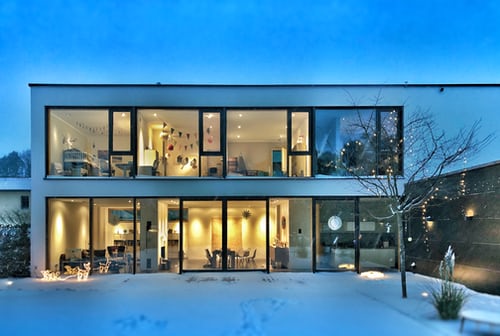Architectural Design Styles for Your New Home
By Beni Restea
Whether you've commissioned a team of contractors or you're doing the work yourself, home construction is a long and arduous process. From choosing the right materials to deciding how big you want your new home to be, it always seems like there are a dozen decisions to be made today, and a dozen more that will need your attention tomorrow.
Before construction can even begin, you'll need to know what you want your home to look like, in a general sense. What influences do you want to draw inspiration from, and what other buildings would you like your house to resemble? What feeling would you like your home to evoke in visitors? These are all questions that you'll need to ask yourself before you break ground on your new home. Will you opt for an innovative construction method like a 3D printed home or prefab?
This is where architectural style comes into play. There is a wide variety of architectural styles that can be put to use that serve a number of different practical purposes and evoke specific aesthetic looks. If you want your house to stand out from the rest, you're going to need to choose one of these styles.
Which style you choose depends on you. Different styles carry different practical benefits and aesthetic looks, but also certain downsides. When you're making your decision, you'll need to think long and hard about what you want from your new home, considering each of the major architectural styles in turn. Here are some of those styles!
Modern architecture
The beginnings of this architectural style can be traced back to the great Louis Sullivan, one of the great architects of the twentieth century. Many things have remained the same throughout the evolution of the ideas surrounding modern architecture, resulting in a relatively consistent aesthetic and functional appearance.
Modern architecture hinges on one simple concept: the prioritization of function over form.

Modernist architecture focuses on creating functional and eco-friendly living spaces, with comparatively little emphasis on decorative elements and functionally redundant features. Due to this uniform ideation, modern architecture has remained aesthetically consistent throughout its history.
As for construction materials and techniques, modern architecture relies heavily on concrete and glass as both a structural component and an aesthetic feature. Modern homes typically incorporate pronounced angular surfaces, large windows, and flat roofs, although elements from other architectural styles may also appear from time to time.
Contemporary architecture
Although it shares many of its core characteristics with modern architecture, contemporary architecture is easily distinguishable from modern architecture. While the minimalistic "less is more" aesthetics of modern architecture do make appearances in a lot of contemporary architecture, the two are not to be confused with one another.
Contemporary architecture has shown itself to be less concrete (pun intended) than modern architecture, with stylistic and functional changes falling in and out of fashion throughout the years. This makes it somewhat difficult to define this particularly nebulous architectural style, but it can generally be defined by simply referring to whatever is currently in vogue.
Although contemporary residential architectures nebulous nature remains a bit abstract, one will usually see contemporary structures using large amounts of glass and concrete, much like modern architecture. Plate glass windows are very common on these structures, and are one of the most consistent hallmarks of a contemporary home.

Traditional architecture
As its name suggests, traditional architecture draws inspiration from the residential architecture that has become commonplace in North America over the past century. As one of the most ubiquitous residential architectural styles, homes built in this way are prized for their comforting familiarity and unmistakably reassuring appearance.
Unlike the previous two entries on this list, traditional architecture has no definite beginning in architectural history; it's simply an amalgamation of the popularized techniques and styles in North America. In spite of this, there are many influences on display in this architectural style that range from southern colonial architecture to Greek and Roman classical architecture.
This architectural style is characterized by wood frame construction, with an emphasis on decorative trappings like ornate trim, pane glass windows and multi-angled roofs. With its simpler and cheaper structural makeup, traditional style homes are a great choice for home builders with limited budgets.
Postmodern architecture
Much like contemporary and modern architecture, postmodern architecture features a heavy emphasis on a minimalistic design, but adds a degree of appreciation for the past's architectural styles. Combining modern and traditional architecture, postmodern architecture is one of the most unique architectural styles currently used today.
Postmodern architecture makes use of its mix of modern and traditional architecture to imbue its constructions with a degree of meaning that is seldom seen in other styles. With its uniquely beautiful and invariably unique aesthetics, its avant-garde appeal is extremely popular with artists and thinkers.
Despite its focus on incorporating elements of the past into its aesthetics and construction, postmodernist architecture usually relies heavily on concrete and glass to affect a similar appearance to older buildings, while retaining its structural ties to modern architecture. As a result of this, many postmodern buildings are more structurally sound than traditional ones, and require far less upkeep.
Conclusion
Well, there you have it. Four of the most popular architectural styles in residential and commercial construction. Upon further study, you'll find that there is a wide variety of subclasses, offshoots, and schools of design that in one way or another draw inspiration from these styles, but these are inarguably the most common.
If you're thinking of building a house in one of these styles, you're probably going to need the help of someone with a bit more experience than you. Whether you're looking for a plot of land to build on or you've already bought one and just want to talk with a real estate professional, the best way to do that is to contact a real estate agent near you. You're sure to benefit from the conversation. We wish you the best of luck with the construction!
